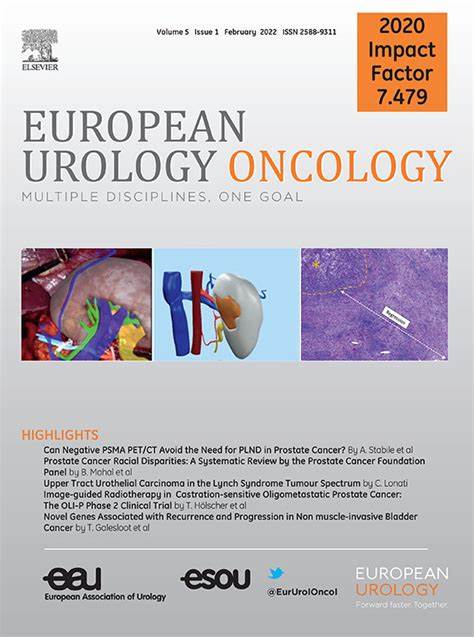Challenges in Defining Clinical Complete Response to Systemic Therapy in Muscle-invasive Bladder Cancer: Insights from the EORTC STARBURST Project
IF 9.3
1区 医学
Q1 ONCOLOGY
引用次数: 0
Abstract
The standard of care (SOC) for treatment of muscle-invasive bladder cancer is neoadjuvant systemic treatment (NAT) with chemotherapy ± immunotherapy (pending durvalumab approval for this indication) followed by cystectomy or radiochemotherapy, regardless of the extent of any tumor response. Studies have recently begun to question the pertinence of local treatment in cases with a complete clinical response after NAT. However, such a de-escalation strategy is hampered by the poor correlation between clinical evaluation of the tumor response and final pathology results for radical cystectomy specimens. The aim of the EORTC STARBURST-1 trial is to develop and validate a multimodal assessment protocol to enhance prediction of the response to systemic treatment. This will include cystoscopy, multiparametric magnetic resonance imaging of the bladder, quantification of circulating plasma and urinary tumor DNA, and measurement of urinary biomarkers. If this protocol can be validated, it will be used in STARBURST-2 to randomize patients to either SOC or to NAT, followed by local treatment or a risk-adapted strategy according to the response to NAT. This strategy involves omitting local treatment and replacing it with intravesical or systemic treatments for complete responders, or with immediate systemic escalation in nonresponders.
定义肌肉侵袭性膀胱癌全身治疗的临床完全缓解的挑战:来自EORTC STARBURST项目的见解。
治疗肌肉侵袭性膀胱癌的标准护理(SOC)是新辅助全身治疗(NAT),化疗±免疫治疗(待durvalumab批准该适应症),然后是膀胱切除术或放化疗,无论任何肿瘤反应的程度如何。最近的研究开始质疑在NAT后临床反应完全的病例中局部治疗的针对性。然而,这种降级策略受到肿瘤反应的临床评估与根治性膀胱切除术标本的最终病理结果相关性较差的阻碍。EORTC STARBURST-1试验的目的是开发和验证一种多模式评估方案,以增强对全身治疗反应的预测。这将包括膀胱镜检查、膀胱多参数磁共振成像、循环血浆和泌尿肿瘤DNA的量化以及泌尿生物标志物的测量。如果该方案可以被验证,它将在STARBURST-2中使用,将患者随机分配到SOC或NAT,然后根据对NAT的反应进行局部治疗或风险适应策略。该策略包括省略局部治疗,代之以完全缓解者的膀胱或全身治疗,或对无反应者立即进行全身升级治疗。
本文章由计算机程序翻译,如有差异,请以英文原文为准。
求助全文
约1分钟内获得全文
求助全文
来源期刊

European urology oncology
Multiple-
CiteScore
15.50
自引率
2.40%
发文量
128
审稿时长
20 days
期刊介绍:
Journal Name: European Urology Oncology
Affiliation: Official Journal of the European Association of Urology
Focus:
First official publication of the EAU fully devoted to the study of genitourinary malignancies
Aims to deliver high-quality research
Content:
Includes original articles, opinion piece editorials, and invited reviews
Covers clinical, basic, and translational research
Publication Frequency: Six times a year in electronic format
 求助内容:
求助内容: 应助结果提醒方式:
应助结果提醒方式:


